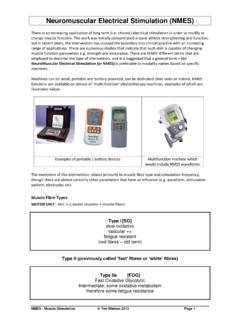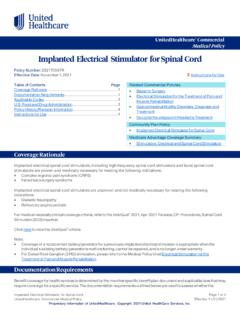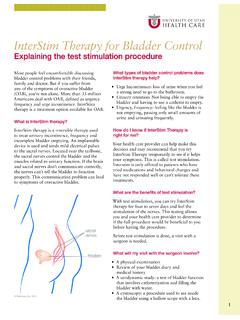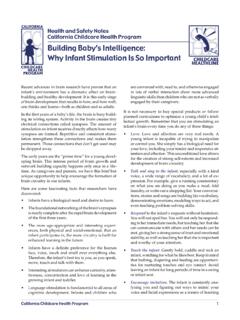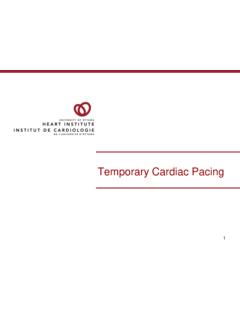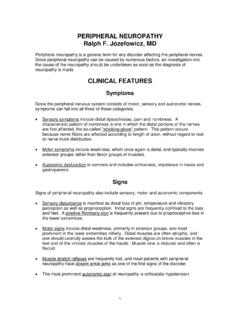Transcription of CO Pelvic floor physical therapy in the treatment of ...
1 CE: Swati; GCO/310616; Total nos of Pages: 9;GCO 310616 CURRENTOPINIONP elvic floor physical therapy in the treatmentof Pelvic floor dysfunction in womenShannon L. Wallacea, Lucia D. Millerb, and Kavita MishraaPurpose of reviewTo describe the principles of Pelvic floor physical therapy (PFPT), review the evidence for PFPT as atreatment for Pelvic floor dysfunction, and summarize the current recommendations for PFPT as a first-lineconservative treatment option for Pelvic floor findingsPelvic floor dysfunction can cause voiding and defecation problems, Pelvic organ prolapse (POP), sexualdysfunction, and Pelvic pain. PFPT is a program of functional retraining to improve Pelvic floor musclestrength, endurance, power, and relaxation in patients with Pelvic floor dysfunction. Based on the availableevidence, PFPT with or without supplemental modalities can improve or cure symptoms of urinaryincontinence, POP, fecal incontinence, peripartum and postpartum Pelvic floor dysfunction, and hypertonicpelvic floor disorders, including Pelvic floor myofascial pain, dyspareunia, vaginismus, and , there is conflicting evidence regarding the effectiveness of perioperative PFPT before or after POPand urinary incontinence has robust evidence-based support and clear benefit as a first-line treatment for most Pelvic floordisorders.
2 Standards of PFPT treatment protocols, however, vary widely and larger well designed trials arerecommended to show long-term Pelvic floor disorders, Pelvic floor dysfunction, Pelvic floor physical therapy , Pelvic organ prolapse,urinary incontinenceINTRODUCTIONP elvicfloorphysicaltherapy(PFPT),alsorefe rredtoaspelvicfloormuscletraining(PFMT), isaconservative,first-line treatment for many Pelvic floor disorders[1&]. PFPT is a general term for the instruction ofpelvic muscle strengthening, relaxation, and coordi-nation exercises by a trained physical therapist [2](Table1).PFPT mayinvolvemanualtherapy,biofeed-back or electrical stimulation, behavioral education,and the creation of home exercise programs [3]. PFPThas robust evidence-based support as a first-line,minimally invasive option to treat Pelvic floor dys-function,includingpelvicorganprolaps e(POP),fecalor urinary incontinence,peripartumand postpartumpelvic floor dysfunction and chronic Pelvic pain [4 6].
3 In this review, we will describe Pelvic floor dis-orders that may benefit from a trial of PFPT anddiscuss the evidence for these OF Pelvic floor PHYSICALTHERAPYDeLancey [7] and Norton [8] argued that when thepelvic floor muscles have normal strength and tone,the Pelvic organs are supported with limited tensionon the ligaments and fascia of the pelvis. Thesepelvic floor muscles may become stretched duringchildbirth, weak during aging, or hypertonic withincreased stress, eventually leading to Pelvic floordysfunction. Strain on the Pelvic connective tissuescan lead to a myriad of Pelvic floor disorders [9,10].PFPT aims to restore normal Pelvic muscle strength,endurance, power, resting tone or a combination ofthese to reverse damage to the muscles and connec-tive tissue [11].aDivision of Urogynecology, Department of Obstetrics and Gynecology,Stanford University Hospital, Palo Alto andbStanford Pelvic HealthCenter, Redwood City, California, USAC orrespondence to Kavita Mishra, Division of Urogynecology, Depart-ment of Obstetrics and Gynecology, Stanford University Hospital, 300 Pasteur Drive, Grant HG332, Palo Alto, CA 94305, : +1 650 725 5986; fax: +1 650 7237737;e-mail: Opin Obstet Gynecol2019, 31:000 000 Copyright 2019 Wolters Kluwer Health, Inc.
4 All rights 2019 Wolters Kluwer Health, Inc. Unauthorized reproduction of this article is : Swati; GCO/310616; Total nos of Pages: 9;GCO 310616 Pelvic floor ANATOMY ANDPHYSIOLOGYA good understanding of Pelvic anatomy andneurophysiology is critical to accurate diagnosisand management with appropriate physicaltherapy techniques. The deep Pelvic floor musclesinclude the coccygeus muscles and the levatorani muscle complex, including the puborectalis,pubococcygeus, and iliococcygeus muscles (Fig. 1).These muscles maintain Pelvic floor tone andprotect the connective tissues from excess load[12]. The superficial Pelvic floor muscles, alsoknown as the urogenital diaphragm, includethe bulbospongiosus, ischiocavernosus, superficialanddeeptransverseperinealmusc les,fasciallayers,and urethral and anal sphincters. The perinealbody or central perineal tendon is the convergenceof the superficial Pelvic muscles and sphinctersand provides support to the Pelvic floor [13].
5 Theobturator internus and piriformis muscles aremuscles of the Pelvic side walls and externally rotatethe femur [14]. The Pelvic floor muscles are inner-vated by sacral nerve roots, the pudendal nerve, andthe levator ani nerve. These nerves and the pelvicfloor muscles, which are 70% slow-twitch, striatedskeletal muscle, provide nearly constant muscle toneto the Pelvic floor , maintaining urinary and fecalcontinence [15]. physical therapy EXAMINATIONPFPT examination and treatment include both inter-nal and external components. During external exami-nation, the lumbosacral and sacroiliac joints, iliopsoasand piriformis muscles, iliacus and rectus abdominismuscle insertions, and abdominal viscera and bladderare palpated for points of tenderness. An exam fordiastasis recti abdominus, abdominal hernia, andinguinal hernia is also performed. During internalexamination, Pelvic floor muscles are assessed fortone, elasticity, and areas of tenderness and pain[17&].
6 The examiner also evaluates the patient s abilitytoperformvoluntarycontractionandv oluntaryrelax-ation, assessing coordination, muscle length,strength, and endurance. An assessment for POPand Pelvic floor descent with Valsalva maneuver isalso performed. The rest of the internal examinationincludes palpation of the obturator internus, puden-dal nerve in Alcock s canal, periurethral connectivetissue, ,thephysicaltherapist will link the objective findings to specificsymptoms and devise a treatment floor physical THERAPYIn addition to manual manipulation, modalitiessuch as electrostimulation, biofeedback, and vaginaldilators or vaginal weighted cones can be used tohelp with isolation of Pelvic floor musculature andimprove contraction [18 21].(1) Electrical stimulation provides a small electricalcurrent to contract the Pelvic floor and assist thepatient in isolation of the proper muscles.
7 (2) Biofeedback uses a vaginal or rectal pressuresensor to provide an audible and/or visualKEY POINTS PFPT is a program of exercise to improve Pelvic floormuscle strength, endurance, power, relaxation or acombination of these. PFPT is performed by physical therapists who completespecialized PFPT training and are licensed by theAmerican physical therapy Association. Robust evidence-based support recommends PFPT with orwithout supplemental modalities for the treatment ofurinary incontinence, POP, fecal incontinence, peripartumand postpartum Pelvic floor dysfunction, and hypertonicpelvic floor disorders, including Pelvic floor myofascialpain, dyspareunia and vaginismus, and vulvodynia. There is conflicting evidence regarding the effectivenessof perioperative PFPT before or after POP and urinaryincontinence surgery and further research trials neededto establish floor physical therapy training andcertificationPFPT is performed by physical therapists who complete specializedPFPT training and are licensed by the APTAAPTA offers two types of certification to physical therapistswho have completed PFPT training:The CAPP: awarded to physical therapists who have completedcomprehensive training, and testing programs from Pelvic floordysfunctionThe WCS certification: indicates the highest level of proficiencyin evaluating and treating all women s health diagnoses,including Pelvic floor painWhile treatment regimens may vary.
8 Most Pelvic therapists recommend 4 8 hour-long sessions everyweek with home exercisesDepending on the severity and complexity of symptoms, somewomen may need to continue PFPT for several monthsThe APTA provides directories of certified providersFor CAPP: WCS: , American physical therapy Association; CAPP, Certificate ofAchievement in Pelvic physical therapy ; PFPT, Pelvic floor physical therapy ;WCS, Women s Health Clinical 31 Number 00 Month 2019 Copyright 2019 Wolters Kluwer Health, Inc. Unauthorized reproduction of this article is : Swati; GCO/310616; Total nos of Pages: 9;GCO 310616feedback of the strength of the muscle contrac-tion (Fig. 2).(3) A vaginal weighted cone is inserted into thevagina and held in place by Pelvic muscle con-tractions during floor physical therapy FORLOW-TONE Pelvic floor DISORDERSS tress urinary incontinenceStress urinary incontinence (SUI) is the involuntaryloss of urine associated with increased intra-abdomi-nal pressure during activities, such as coughing,laughing, sneezing, impact movements or squatting[6,22].
9 It affects 25 45% of women [23,24]. Pelvicfloor muscle contraction can increase urethralpressure and elevate the urethra under the pubicsymphysis to maintain continence and prevent uri-nary leakage. PFPT is used to strengthen and supportthe Pelvic floor structures to improve SUI [25].A recent 2018 Cochrane Review assessed 31 ran-domized controlled trials (RCTs) of PFPT for womenwith urinary incontinence. Women with SUI whowere in the PFPT groups were eight times more likelyto report cure (56 versus 6%; risk ratio ) and sixtimes more likely to report cure or improvement (74versus 11%; risk ratio ) than women in the pla-cebo, sham, or no treatment groups [26&&]. A 2019systematic review of 11 RCTs of PFPT with biofeed-back versus conservative treatment found thatbiofeedback did not offer additional symptomimprovement in women with SUI [27&]. In two sin-gle-blinded RCTs, however, the highest cure rateswere in the treatment arms of combined PFPT withbiofeedback and electrical stimulation.
10 These studiesalsohadclosefollow-upevery1 2weeks,highadher-ence and low drop-out rates. It is likely that the keyfactors for successful SUI treatment with PFPT areclose follow-up and intensive training [28,29].Overactive bladderOveractive bladder syndrome is a constellation ofsymptoms including urinary urgency, frequency,urgency incontinence (UUI) and nocturia [30].These symptoms are caused by involuntary contrac-tions of the bladder detrusor muscle. Studies haveFIGURE and deep muscles of the Pelvic floor . The deep Pelvic floor muscles include the coccygeus muscles andthe levator ani muscle complex, including the puborectalis, pubococcygeus, and iliococcygeus muscles. The superficial pelvicfloor muscles, also known as the urogenital diaphragm, include the bulbospongiosus, ischiocavernosus, superficial and deeptransverse perineal muscles, fascial layers, and urethral and anal sphincters [16].
